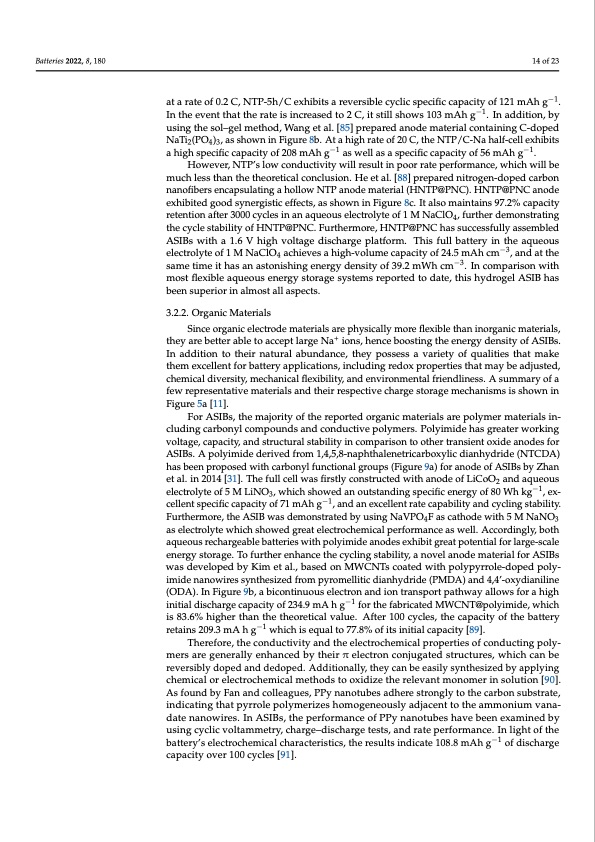
PDF Publication Title:
Text from PDF Page: 014
Batteries 2022, 8, 180 14 of 23 at a rate of 0.2 C, NTP-5h/C exhibits a reversible cyclic specific capacity of 121 mAh g−1. In the event that the rate is increased to 2 C, it still shows 103 mAh g−1. In addition, by using the sol–gel method, Wang et al. [85] prepared anode material containing C-doped NaTi2(PO4)3, as shown in Figure 8b. At a high rate of 20 C, the NTP/C-Na half-cell exhibits a high specific capacity of 208 mAh g−1 as well as a specific capacity of 56 mAh g−1. However, NTP’s low conductivity will result in poor rate performance, which will be much less than the theoretical conclusion. He et al. [88] prepared nitrogen-doped carbon nanofibers encapsulating a hollow NTP anode material (HNTP@PNC). HNTP@PNC anode exhibited good synergistic effects, as shown in Figure 8c. It also maintains 97.2% capacity retention after 3000 cycles in an aqueous electrolyte of 1 M NaClO4, further demonstrating the cycle stability of HNTP@PNC. Furthermore, HNTP@PNC has successfully assembled ASIBs with a 1.6 V high voltage discharge platform. This full battery in the aqueous electrolyte of 1 M NaClO4 achieves a high-volume capacity of 24.5 mAh cm−3, and at the same time it has an astonishing energy density of 39.2 mWh cm−3. In comparison with most flexible aqueous energy storage systems reported to date, this hydrogel ASIB has been superior in almost all aspects. 3.2.2. Organic Materials Since organic electrode materials are physically more flexible than inorganic materials, they are better able to accept large Na+ ions, hence boosting the energy density of ASIBs. In addition to their natural abundance, they possess a variety of qualities that make them excellent for battery applications, including redox properties that may be adjusted, chemical diversity, mechanical flexibility, and environmental friendliness. A summary of a few representative materials and their respective charge storage mechanisms is shown in Figure 5a [11]. For ASIBs, the majority of the reported organic materials are polymer materials in- cluding carbonyl compounds and conductive polymers. Polyimide has greater working voltage, capacity, and structural stability in comparison to other transient oxide anodes for ASIBs. A polyimide derived from 1,4,5,8-naphthalenetricarboxylic dianhydride (NTCDA) has been proposed with carbonyl functional groups (Figure 9a) for anode of ASIBs by Zhan et al. in 2014 [31]. The full cell was firstly constructed with anode of LiCoO2 and aqueous electrolyte of 5 M LiNO3, which showed an outstanding specific energy of 80 Wh kg−1, ex- cellent specific capacity of 71 mAh g−1, and an excellent rate capability and cycling stability. Furthermore, the ASIB was demonstrated by using NaVPO4F as cathode with 5 M NaNO3 as electrolyte which showed great electrochemical performance as well. Accordingly, both aqueous rechargeable batteries with polyimide anodes exhibit great potential for large-scale energy storage. To further enhance the cycling stability, a novel anode material for ASIBs was developed by Kim et al., based on MWCNTs coated with polypyrrole-doped poly- imide nanowires synthesized from pyromellitic dianhydride (PMDA) and 4,4’-oxydianiline (ODA). In Figure 9b, a bicontinuous electron and ion transport pathway allows for a high initial discharge capacity of 234.9 mA h g−1 for the fabricated MWCNT@polyimide, which is 83.6% higher than the theoretical value. After 100 cycles, the capacity of the battery retains 209.3 mA h g−1 which is equal to 77.8% of its initial capacity [89]. Therefore, the conductivity and the electrochemical properties of conducting poly- mers are generally enhanced by their π electron conjugated structures, which can be reversibly doped and dedoped. Additionally, they can be easily synthesized by applying chemical or electrochemical methods to oxidize the relevant monomer in solution [90]. As found by Fan and colleagues, PPy nanotubes adhere strongly to the carbon substrate, indicating that pyrrole polymerizes homogeneously adjacent to the ammonium vana- date nanowires. In ASIBs, the performance of PPy nanotubes have been examined by using cyclic voltammetry, charge–discharge tests, and rate performance. In light of the battery’s electrochemical characteristics, the results indicate 108.8 mAh g−1 of discharge capacity over 100 cycles [91].PDF Image | Aqueous Rechargeable Sodium-Ion Batteries Hydrogel

PDF Search Title:
Aqueous Rechargeable Sodium-Ion Batteries HydrogelOriginal File Name Searched:
batteries-08-00180-v2.pdfDIY PDF Search: Google It | Yahoo | Bing
Salgenx Redox Flow Battery Technology: Salt water flow battery technology with low cost and great energy density that can be used for power storage and thermal storage. Let us de-risk your production using our license. Our aqueous flow battery is less cost than Tesla Megapack and available faster. Redox flow battery. No membrane needed like with Vanadium, or Bromine. Salgenx flow battery
| CONTACT TEL: 608-238-6001 Email: greg@salgenx.com | RSS | AMP |